Picking a bed size is a big decision for your bedroom. The right bed should feel comfortable and leave you enough space to actually move around.
Remember to repin your favorite images!
Try not to let your bed take up more than 60% of your bedroom. That way, you’ll still have room for furniture and can walk around without bumping into things.
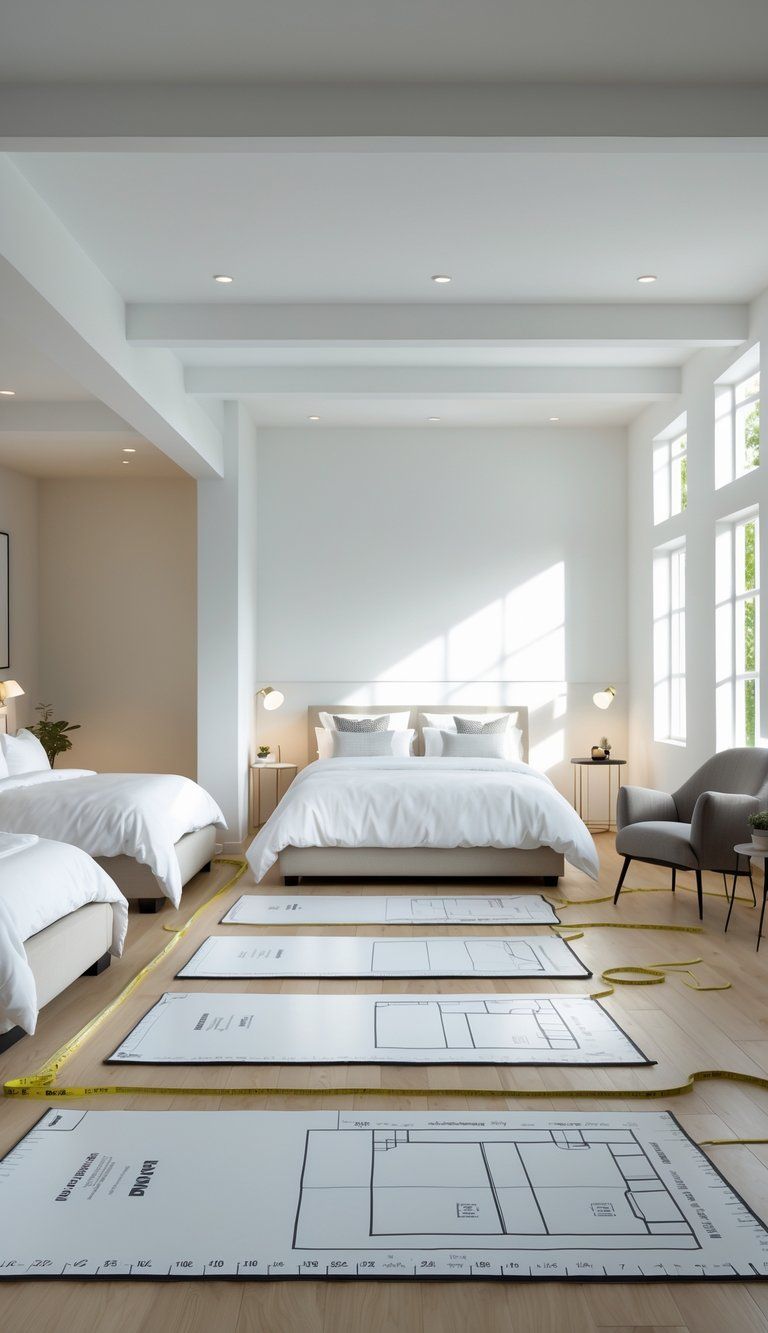
Your bedroom’s dimensions really matter here. Sure, a king-size bed sounds dreamy, but you’ll need at least a 12 x 12 foot room to make it work with other furniture.
Smaller rooms? Maybe go for a queen or full, and try to keep the bed centered so the space feels balanced.
Bed size isn’t just about the look of your room. Your height, whether you share the bed, and your sleep habits all matter.
Tall folks might want a bed that’s at least 80 inches long. Couples usually need at least a queen (60 inches wide) if they want to sleep comfortably.
Measure your space before you shop. It’s no fun hauling in a bed that ends up swallowing the whole room.
Understanding Bed Sizes

Picking the right bed size really affects how your room feels and works. Bed dimensions vary a lot, so knowing the basics helps you make a smarter choice.
Standard US Bed Dimensions
Here are the six standard US bed sizes:
| Bed Type | Width | Length | Best For |
|---|---|---|---|
| Twin | 38″ | 75″ | Children, small guest rooms |
| Twin XL | 38″ | 80″ | Taller teens, college dorms |
| Full | 54″ | 75″ | Single adults, small bedrooms |
| Queen | 60″ | 80″ | Couples, medium bedrooms |
| King | 76″ | 80″ | Couples who want space, large bedrooms |
| California King | 72″ | 84″ | Taller people, long bedrooms |
Leave at least 2-3 feet of space around the bed. You’ll want to move around and make the bed without feeling boxed in.
Comparing Twin, Full, Queen, King, and California King Beds
Twin beds work great for kids’ rooms or tight spaces. At 38″ wide, they’re narrow but do the job for a single sleeper.
Full beds are a bit wider (54″) but just as long as twins. Single adults get more wiggle room, but couples might feel squeezed.
Queen beds hit that sweet spot—60″ wide, so couples have more space, and they fit into most bedrooms.
King beds are massive at 76″ wide. Each person gets the same width as a twin, which is honestly pretty nice if you like your space.
California Kings are a bit narrower than kings but longer, so tall people can finally stretch out.
Assessing Your Room Space
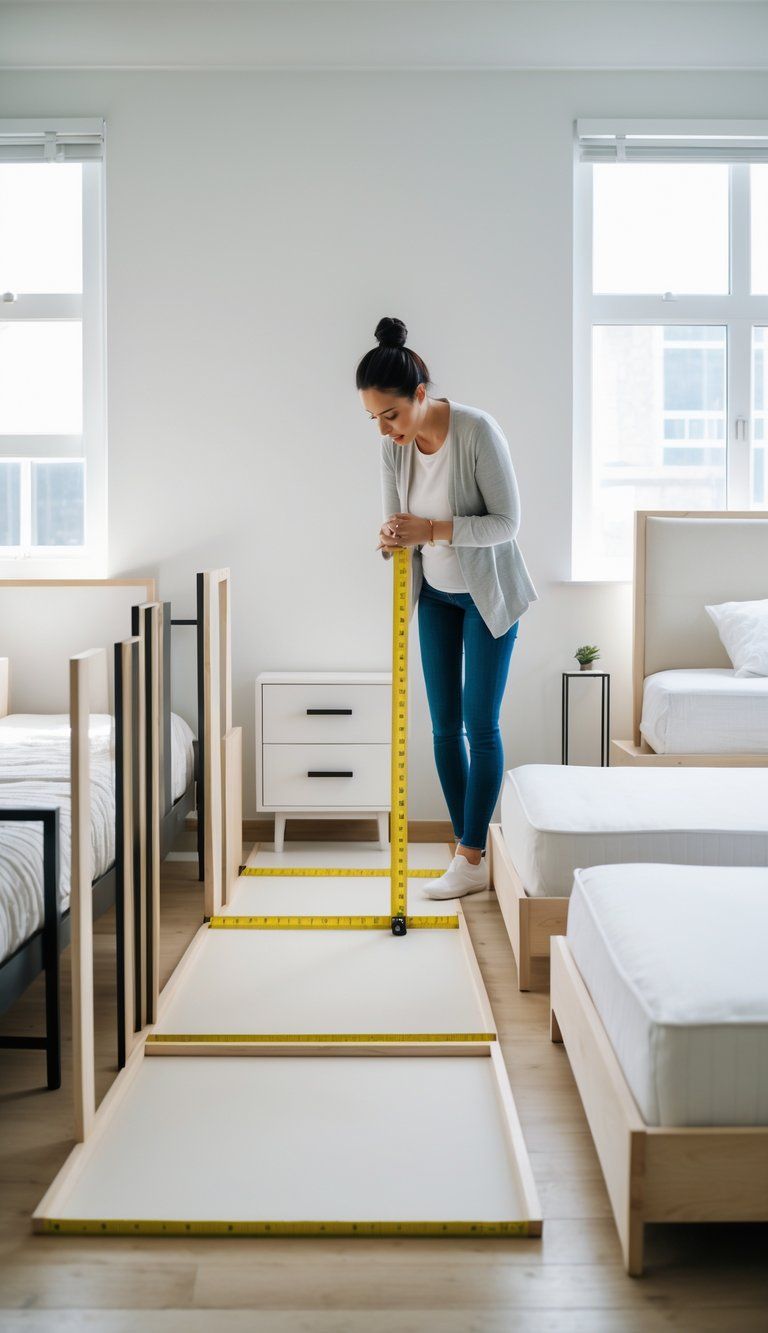
Before you pick a bed, get clear on how much space you actually have. Measuring and planning ahead can save you a lot of headaches (and backaches).
Measuring Room Dimensions
Grab a tape measure and jot down your room’s length and width. Don’t forget about doors, windows, closets, and any permanent fixtures that eat up wall space.
Aim for at least 2 feet of space around three sides of your bed. You can push one side against the wall if you have to.
Sketch a quick floor plan or use a free app. Mark outlets, vents, and switches so you don’t end up blocking them with your bed.
Optimizing Layout for Furniture
Beds aren’t the only thing in your bedroom. Think about what else you need—dressers, nightstands, maybe a desk or a chair.
Try to leave at least 30 inches between big pieces of furniture. That way, you can actually walk through the room without doing a weird sideways shuffle.
Nightstands should match your bed’s height. Most are 24-28 inches tall, which lines up with most mattresses.
Here’s a rough guide for bed sizes to room sizes:
- Twin/Twin XL: 7′ x 10′ room or bigger
- Full/Double: 10′ x 10′ room or more
- Queen: 10′ x 12′ room or larger
- King/Cal King: 12′ x 12′ room or up
Navigating Small and Large Bedrooms
If your bedroom is small, look for beds with storage drawers underneath. Wall-mounted nightstands and sconces can save precious floor space.
Go for a twin or full bed in rooms under 120 square feet. Put the bed along the longest wall so the space feels less cramped.
Got a big bedroom? Resist the urge to just get the biggest bed possible. Instead, create different zones—sleeping, dressing, maybe a little reading nook.
Balance matters. Even if a king bed technically fits, it might make the room feel tight if it hogs too much floor space.
Evaluating Sleep Needs and Preferences
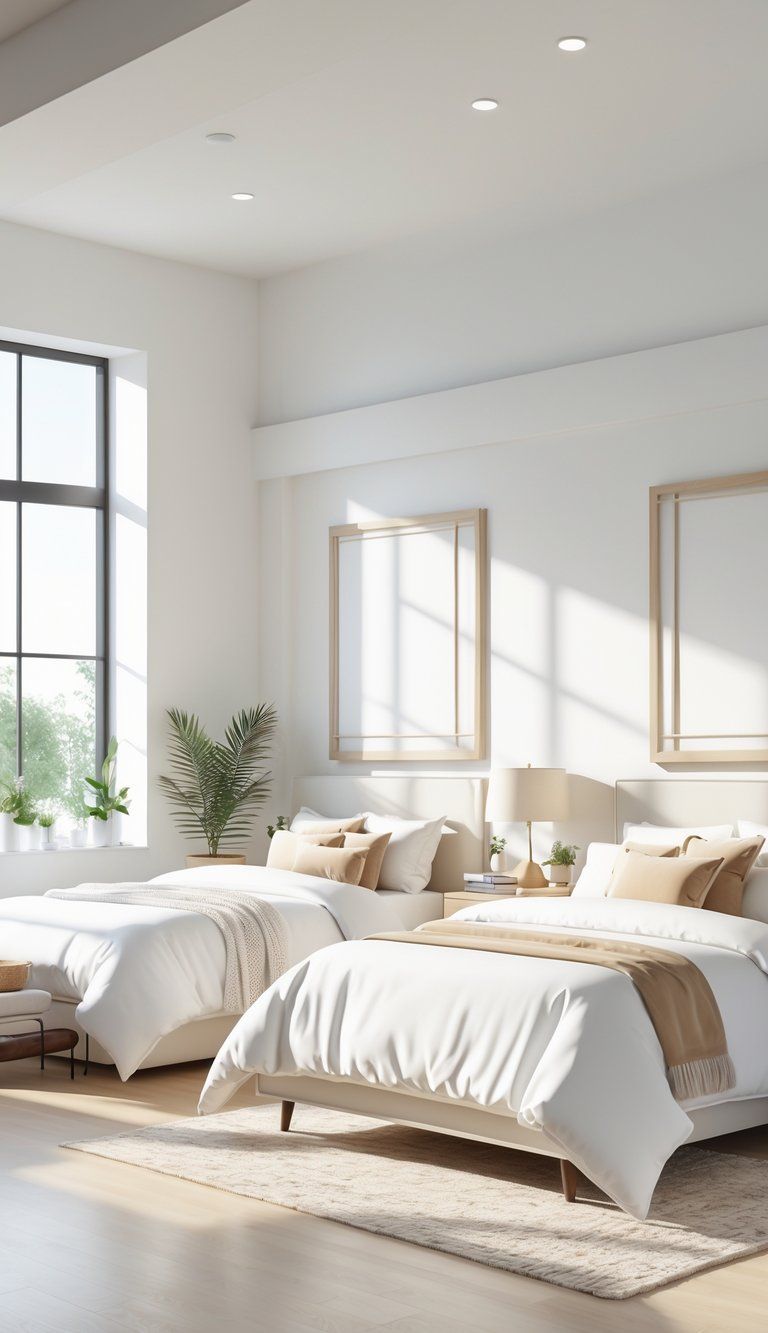
Think about who’s using the bed and what helps them sleep best. Your sleep environment really affects how you rest, so let your personal needs guide you.
Single Sleepers vs. Couples
If you sleep solo, you’ve got options. Twin beds (38″ × 75″) are fine for kids or adults in tight spaces.
Single adults who want to stretch out a bit more might like a twin XL (38″ × 80″). It’s just a little longer but makes a difference.
Full beds (54″ × 75″) give you more room without dominating the whole room. But keep in mind, each person in a full gets only about 27 inches—less than a solo twin.
Couples usually go for a queen (60″ × 80″). Each person gets about 30 inches. If you want to spread out, a king (76″ × 80″) gives each person 38 inches—same as a twin, but for two.
Considering Height and Comfort
Your height matters—if you’re over 6 feet, twin and full beds (both 75″ long) might leave your feet dangling.
Twin XL, queen, king, or California king beds all have 80″ or more in length. California king (72″ × 84″) is the longest, though a bit narrower.
Think about how you sleep, too. Side sleepers usually want more width for bent knees. Stomach and back sleepers might care more about length.
Bedding gets pricier as beds get bigger. Queen sheets and comforters cost more than twin or full, and king-size sets can get expensive.
Choosing Beds for Specific Rooms
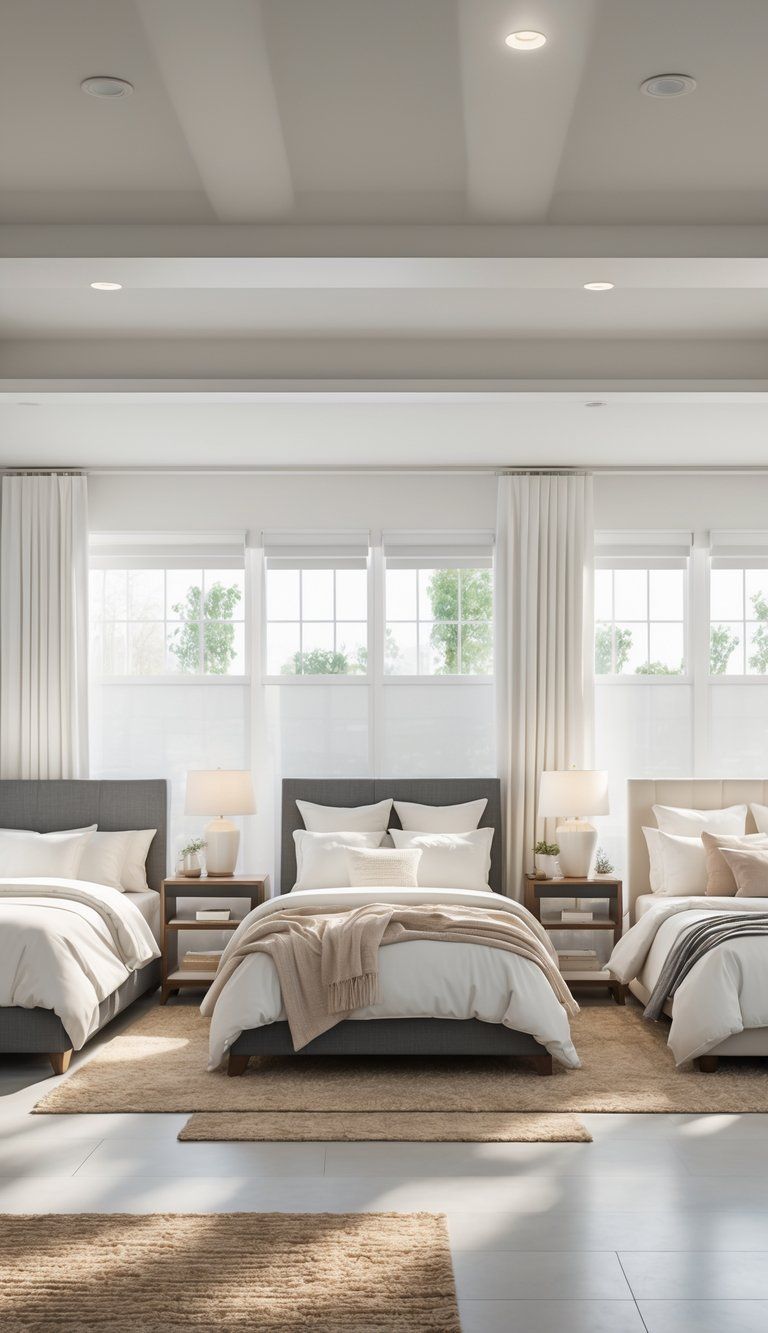
Every room is different, and the right bed depends on who’ll use it and how much space you’ve got.
Selecting the Right Size for Guest Bedrooms
Guest rooms should feel welcoming but not overstuffed. A full bed (54″ x 75″) usually works for most guests, giving enough space for one person or two who don’t mind being close.
If space is tight, a twin (38″ x 75″) saves room and still feels comfy for a single visitor. If couples visit, a queen (60″ x 80″) is a solid choice.
Leave at least 2 feet of space around the bed so guests can move around and stash their luggage.
Guest Room Bed Options:
- Small rooms: Twin or full bed
- Medium rooms: Full or queen bed
- Large rooms: Queen bed
Add a nightstand and a lamp so guests feel at home.
Kids’ and Teen Bedrooms
Kids’ needs change fast. For toddlers, a twin bed is ideal—easy to make and fits in smaller rooms.
Older kids or teens might like a full bed if you’ve got the space. It’s great for sleepovers and will last them into adulthood.
Bunk beds are awesome for siblings. Twin-over-twin works for younger kids, while twin-over-full gives more space below.
Try to think ahead. That “huge” bed for your eight-year-old might be just right when they’re sixteen. Teens also want space for studying and hanging out.
Master Bedroom Bed Choices
Your master bedroom is where you’ll spend a third of your life, so pick carefully. Most people choose a queen for rooms at least 10′ x 10′.
If your room’s bigger (12′ x 12′ or more), go for a king (76″ x 80″) for max comfort. Tall? California king (72″ x 84″) gives you extra length.
Quick Guide for Master Beds:
- Standard room (10′ x 10′): Queen bed
- Large room (12′ x 12′ or more): King or California king
- Sharing with pets or kids: King for more space
Make sure you can open doors and drawers easily. Leave at least 30 inches of space around the bed so you’re not squeezing past furniture.
Integrating Bed Size With Bedroom Furniture
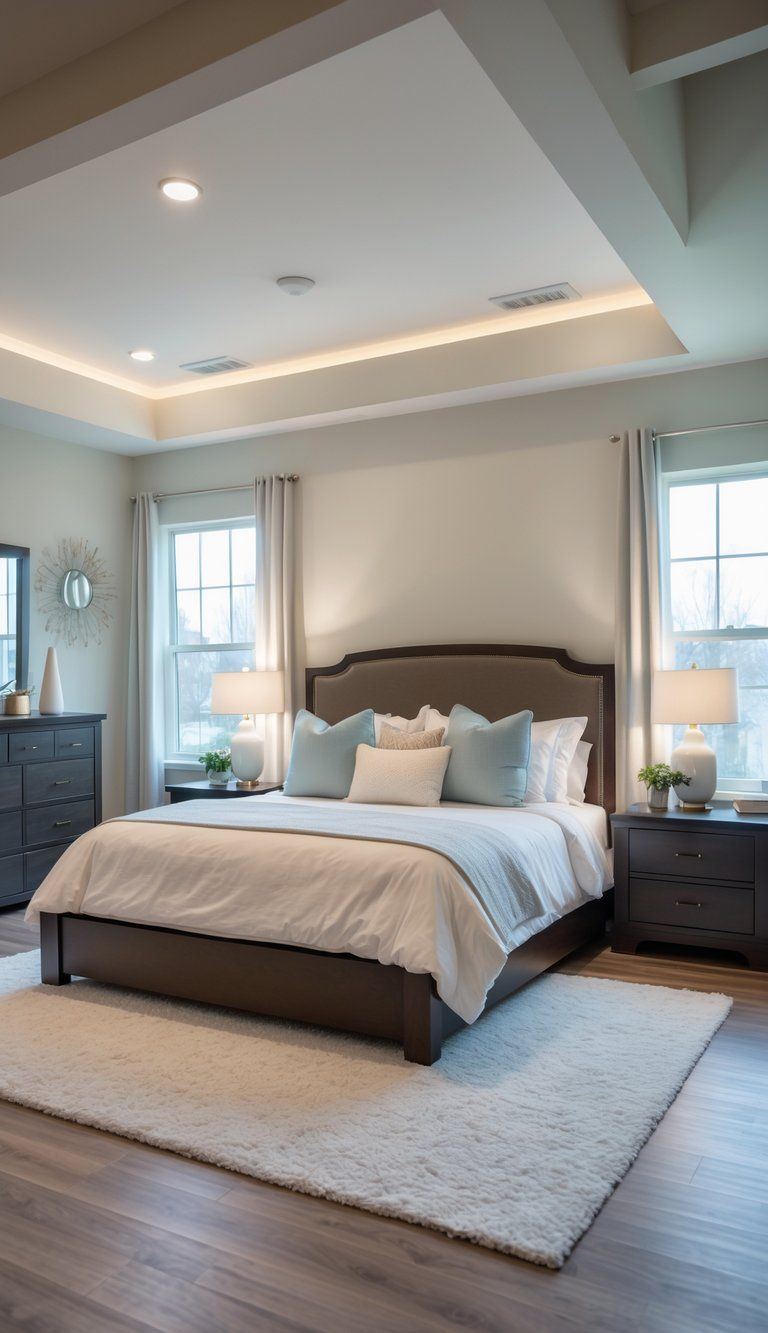
Your bed should anchor your bedroom, but it needs to work with the rest of your furniture. The right mix makes your space both functional and easy on the eyes.
Headboards and Bed Frames
Headboards and bed frames really shape how your bed fits in your space. A platform bed sits lower to the ground, so it takes up less visual space. That style just works, especially if your room has low ceilings or you want a modern look.
If your room’s on the smaller side, try a bed frame with storage underneath. You can stash clutter out of sight and squeeze more out of your space.
Usually, headboards extend a bit beyond the mattress. Be careful with oversized headboards in small rooms—they can totally take over. On the flip side, a tall headboard pulls your eyes up and makes the ceiling feel higher. It really does help create the illusion of height.
Before you buy, measure the bed’s total footprint, including the frame. Make sure you leave at least 24 inches of walking space around it so you’re not squeezing by every morning.
Coordinating Dressers, Nightstands, and More
Try to keep your bedroom furniture proportional to your bed. For a king or queen, pick wide nightstands (think 18-22 inches) so things look balanced. Twin or full beds feel right with narrower nightstands (12-18 inches).
Nightstand height matters too. Aim for something within 2-4 inches of your mattress top, so you don’t have to reach awkwardly when you’re in bed.
Place your dresser where it won’t block walkways. If you’re short on floor space, go for a tall dresser. If you’ve got more room, a wider dresser can look great and hold more stuff.
In smaller bedrooms, multi-functional pieces just make sense. Maybe a chest that holds your TV, or a storage bench at the foot of the bed—anything that does double duty saves you space.
Leave at least 36 inches between the bed and dressers. That way, you can open drawers all the way without bumping into anything.
Bed Styles and Their Impact on Room Space

The bed style you pick changes how your room feels and how comfy it is. Sometimes, the right frame makes a small room seem bigger—or the wrong one can make it feel tight.
Platform Beds Versus Traditional Frames
Platform beds sit close to the floor and don’t need a box spring. This lower look leaves more space above the bed and makes your ceiling seem higher. Most platform beds have simple, straight lines that fit right in with modern decor.
Traditional frames sit higher and usually need a box spring. That extra height can make a room feel a bit more formal, but it might crowd small spaces. You do get storage space underneath for bins or drawers, which is handy.
When you measure for either style, remember:
- Platform beds add around 8-14 inches to your mattress height.
- Traditional frames with box springs add about 18-24 inches.
- Always allow at least 24 inches of walking space around the bed.
Storage Beds and Space-Saving Solutions
Storage beds really change the game in small rooms. They come with drawers underneath or mattress platforms that lift up to reveal storage. This built-in storage means you might not need extra dressers.
Some smart space-saving bed ideas:
- Hydraulic storage beds that lift up for a big storage compartment
- Captain’s beds with drawers in the base
- Murphy beds that fold into the wall when you’re not using them
- Trundle beds with a second mattress tucked underneath
The right storage bed can free up as much as 10 square feet in your room. If you’re in a studio or need a guest room, multifunctional options like daybeds or sofa beds are worth a look.
Final Considerations for Choosing Bed Size
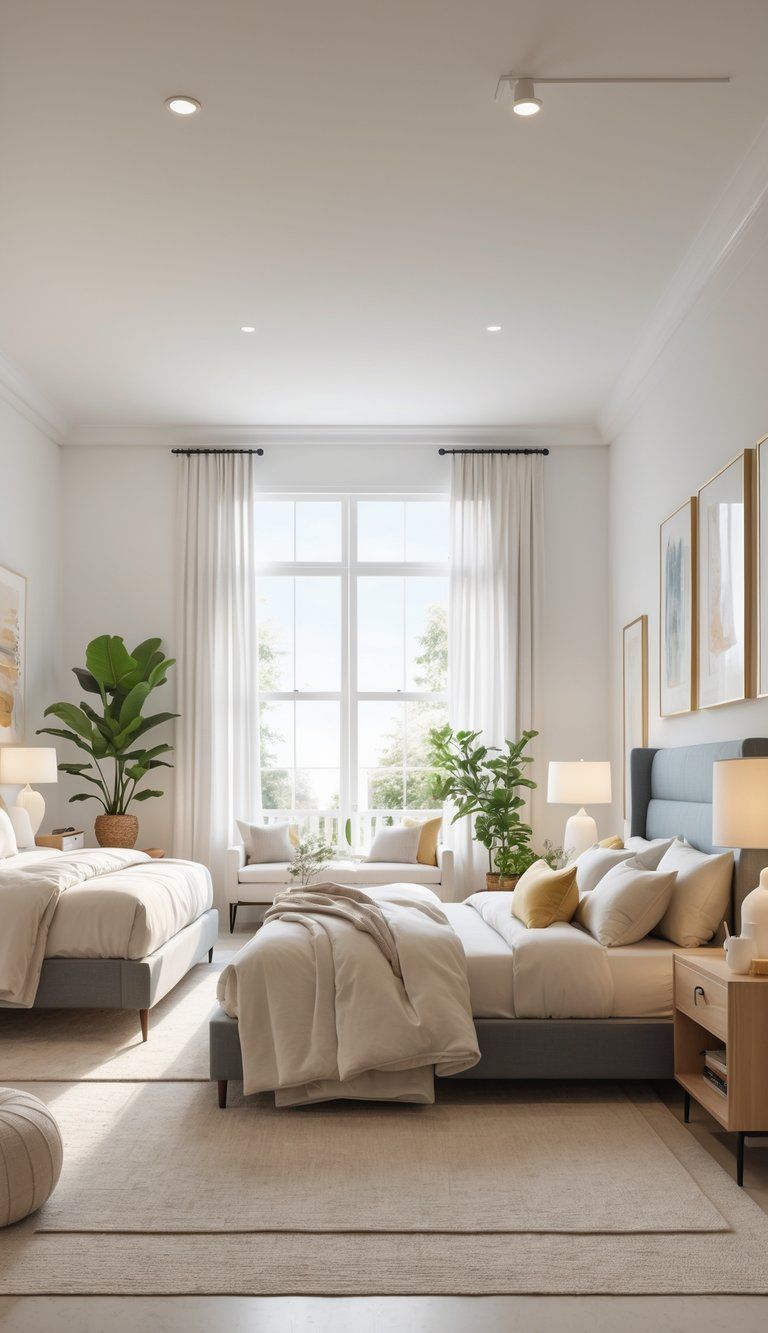
When you’re picking a bed size, think about your long-term needs and what you actually like—not just the room’s measurements.
Budget and Longevity
Your budget covers more than just the frame—it’s the whole sleep setup. A king mattress costs a lot more than a twin, and so do the sheets, pillows, and everything else.
Typical price ranges:
- Twin/Twin XL: $500-$1,000 (for everything)
- Full/Double: $700-$1,500
- Queen: $1,000-$2,500
- King/Cal King: $1,500-$3,500+
How long will you keep this bed? A good mattress lasts 7-10 years. If you might move soon, a smaller bed could be smarter. But if you’re staying put, going bigger might make sense for the long haul.
Style Preferences and Trends
Your bed really sets the tone for your bedroom. It should show off your personal style, don’t you think?
Lately, people lean toward clean lines and minimalist frames. These choices can make any room look bigger and less cluttered.
If you’re working with a small room, try a platform bed with built-in storage. Wall-mounted headboards also save space and add a little flair.
Those options pair nicely with queen or full-size beds. They just seem to fit without overwhelming the space.
Got a bigger room? Go bold with an upholstered headboard or a decorative bed frame. A king bed with a dramatic headboard can really anchor a large space.
Don’t forget about your room’s architecture. In rooms with low ceilings, a lower bed makes the ceiling feel a bit higher.
If you’re lucky enough to have high ceilings, choose a taller bed with a big headboard. It’ll help balance everything out.

